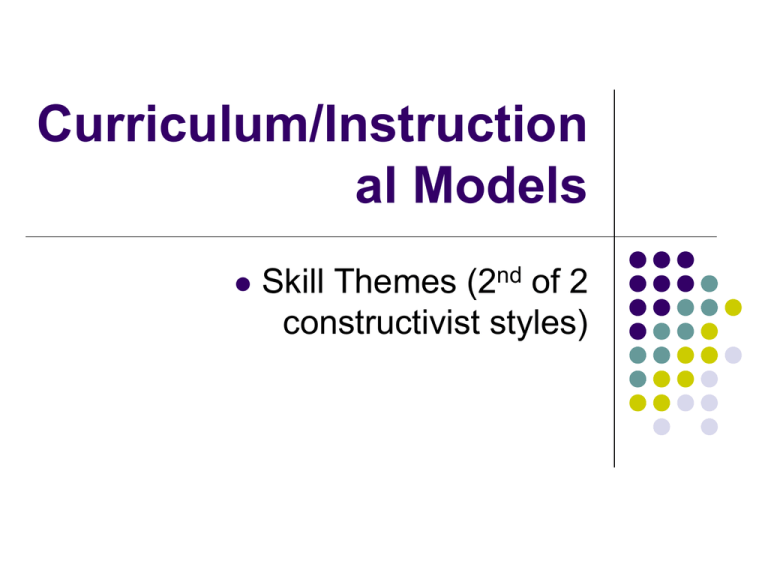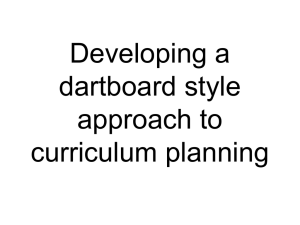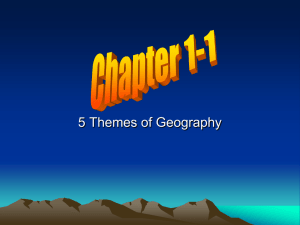skill themes model
advertisement

Curriculum/Instruction al Models Skill Themes (2nd of 2 constructivist styles) 3 W’s of Skill Themes What are skill themes? Developing individual skills (soccer pass) and skill themes (dribbling) using concepts learned in movement education’s concepts. These sport skills later form the basis for traditional sports 3 W’s of Skill Themes When should you transition from movement ed to skill themes? Usually somewhere in the 3rd grade. You will notice students developing past the movement concepts (aka, they’re getting bored). At this point, they are ready for skill themes. 3 W’s of Skill Themes Why use skill themes Students are not developmentally ready for the “full” sports or activities. Playing a basketball game in 4th & 5th grade is inviting DISASTER. DO NOT play “full” sports in 4th & 5th grade Build skills so they can be successful in more complex environments (aka-they’ll be ready) Students enjoy this intermediate step Skill Themes: Developing individual sport skills using movement education’s themes and concepts. Content Skill theme concepts Concept Transfer – from movement ed to skill themes Large surface increases object control Soccer pass with laces/instep Wider base of support for stability Gymnastics Object control more difficult at high speeds Basketball dribbling An off-center force causes rotation Volleyball serve Zigzag pathways are harder to predict Hockey dribbling Free flow produces higher quality movements Many sports How of instruction Which method is movement exploration taught through? Reproductive Styles – Students reproduce teacher understandings 1. 2. 3. 4. 5. COMMAND - Teacher makes all decisions, like “follow the leader” PRACTICE (includes stations) - Students carry out teacher-prescribed tasks as modeled while receiving teacher feedback RECIPROCAL - Students work in pairs: one performs, the other provides feedback (may utilize criteria sheet) SELF-CHECK - Students assess their own performance against criteria sheet prepared by teacher SELF SELECTION - Students are provided with legitimate options for skill practice that have a range of difficulty (low to high) Productive Styles – Students create understandings 6. 7. 8. GUIDED DISCOVERY - Students answer questions in a series that lead to discovery of a concept (typically movement related) PROBLEM SOLVING (includes synthesis) - Students solve problems or create programs with assistance from the teacher, multiple solutions (divergent) INDIVIDUAL PROGRAM - Students develop a program based on physical and cognitive abilities. Organization of Curriculum Content Spiral – revisit concepts periodically to review and enrich. May utilize a schedule to track time devoted to each area. 1. This is the better method….why? Units 2. Organized around related skills Sample Lessons 4th – Movement and Position 4th – Bounce Pass 5th – Cooperative 5th – Throwing Challenge 5th – Dribbling Offense/Defense Activity Advantages: Movement Education and Skill Themes Why Use These Approaches? Spiral curriculum continually reinforces learning (is used) More positive approach to self, sport, and exercise More FUN (evidenced by higher interscholastic athletic participation) De-emphasizes competition and encourages cooperation Permits flexibility and challenge by choice in learning concepts (great for differentiated instruction) Allow Ss to be unique (each child comes in with different aspirations, movement experiences, and needs) Learning can be more private than public due to individualization and high activity time. Uses various teaching styles: Guided discovery, command, reciprocal, problem solving Develops critical thinking, movement vocabulary, creativity, and communication.









